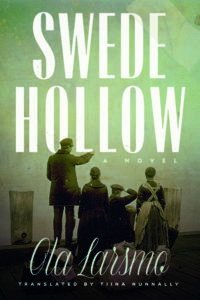Swede Hollow: A Novel

- Year
- 2019
- Creators
- Reviewer: Laurie Murphy
- Topics
Swede Hollow: A Novel
Author: Ola Larsmo; Translated by Tiina Nunnally
Minneapolis, MN: University of Minnesota Press, Translation copyright 2019
312 pages; cloth/jacket; 1 b&w photo; $26.95
As a rule, Ramsey County Historical Society, does not review historical fiction. But we were curious about Ola Larsmo’s Swede Hollow – A Novel, originally written in Swedish and translated by Tiina Nunnally, because the Swede Hollow that most St. Paulites know today is a lovely park that extends through the Dayton’s Bluff and Railroad Island neighborhoods on the East Side. Few remember what life was like among the jumble of small homes and tar paper shacks built precariously along the steep ravine below and near the once-lavish Hamm Mansion on Greenbrier, near East Seventh Street. Part of the intrigue is that there isn’t much information available about the early days of the Swedish immigrants who first inhabited the Hollow, other than that many were poor, and life there was far from easy. With the help of the Minnesota Historical Society, guidance from scholars at several universities, and detailed newspaper accounts, Larsmo weaves a tale that helps readers better understand what life may have been like for the Swedes, the Irish, the Italians, and others who followed, before any remaining traces of the community were burned by the city in 1956, and life as it once was in the Hollow disappeared.
Larsmo tells the story of the Klar Family—Gustaf, his wife Anna, and their three young children, Elisabet, Ellen, and Carl—who flee their home country of Sweden in 1897, hoping for a new beginning and better future in New York City. On the Majestic steamship, the Klars meet Widow Lundgren and her son David, who also are looking for a fresh start. But they are headed to St. Paul, Minnesota, thanks to a letter from a relative who has already made a home there in a place called Swede Hollow. That letter not only changes the course of the Lundgrens’ lives, but the lives of the Klar family and a few other passengers, as well.
Of course, reality is nothing like they imagined, as the families struggle together in their small corner of the world with poverty, lack of education and opportunity, disease, crime, and “ghosts from the past.”
Larsmo is a master of description, bringing the Hollow and the east side of St. Paul to life. It’s rickety and rough, dirty, and bone-chillingly cold in the brutal winters. He incorporates place names, the hard life and dangers that come with working the railroads, the unreachable world the newcomers glimpse through the glass windows of the Hamm Mansion and fancy shops in the city, and actual events—a fire on Ellis Island, the important mission work of The Salvation Army, and one of Duluth’s most horrible moments in history.
The author is less detailed in his character development, however, which might make it harder for readers to connect with the characters. In addition, the novel jumps, unexpectedly at times, from third-person narrative to first person in the middle of chapters. It also occasionally inserts real news articles; a character named Ola Varmlanning, an early inhabitant who pops up from time to time in the narrative but doesn’t live there anymore; and a few “tragic stories” from different perspectives. These all add to the developing story, but it sometimes takes the reader a minute to reorient before continuing on. What’s not always included in the book are specific dates and ages that would help ground the story. For example, readers aren’t told the ages of the Klar children when they arrived in the new country, and thus later, when life-changing events occur, one can only guess at the age of the characters at those times.
That said, Swede Hollow – A Novel is a good read; an interesting, informative, (and cold!) work of historical fiction that illustrates the hardships, tragedies, and perseverance of immigrant life and offers up a well-deserved and heartwarming “victory cheer” at the end—on a warm summer day—in Swede Hollow Park a century later.
Laurie Murphy is a retired executive and a member of the Ramsey County Historical Society Editorial Board.
- Year
- 2019
- Creators
- Reviewer: Laurie Murphy
- Topics